door same color as wall Should interior doors be the same color as the walls?
When it comes to interior design, the color choices for your walls and doors can significantly affect the overall aesthetic and ambiance of a room. One question that frequently arises among homeowners and decorators alike is whether interior doors should match the color of the walls. This article aims to explore this topic in detail, examining the implications of such choices and offering insights for those contemplating a color scheme for their interiors.
Consistency in Color Schemes

Choosing to paint interior doors the same color as the walls creates a seamless look that can enhance the feeling of space within a room. This consistency can make a room feel larger and more uniform, as there are fewer visual breaks. For instance, a soft, neutral color on both walls and doors can open up a small room, while maintaining a cohesive and sophisticated appearance. This strategy is particularly effective in smaller spaces or corridors where the visual flow is essential.
Emphasizing Architectural Features

On the other hand, opting for a contrasting color for doors allows homeowners to highlight these architectural features, drawing attention to the craftsmanship of the doors or the surrounding trim. A bold color choice for the doors can serve as a powerful focal point in a room, creating a striking visual contrast that engages the eye. This approach can be particularly effective in spaces with detailed moldings or uniquely designed doors, where emphasizing these features adds depth and interest to the overall design.
Choosing Colors Based on Room Functionality
The functionality of the room can also play a crucial role in this decision. For example, in spaces that require a sense of calm and relaxation, such as bedrooms or reading areas, soft, unified colors promote tranquility. Conversely, in high-traffic areas like hallways or living rooms, a bolder approach may better withstand the hustle and bustle of daily life while still maintaining visual appeal. By carefully considering the purpose of each room, homeowners can make informed decisions about their color schemes that not only look great but also serve practical purposes.
Trends and Personal Style
Current design trends are leaning toward personalized interiors that reflect individual tastes and lifestyles. As such, many decorators are moving away from rigid color conformity in favor of creative expression. This shift opens up the possibility of mixing and matching colors, textures, and finishes for doors and walls to suit personal style. The beauty of modern interior design lies in its fluidity and adaptability. Homeowners are encouraged to explore diverse palettes and find combinations that resonate with their aesthetic preferences.
The Impact of Lighting
Beyond color and personal preference, lighting can significantly influence how colors are perceived in a space. Natural light, as well as artificial lighting choices, can change the way a color looks at different times of the day. When selecting colors for walls and doors, it’s essential to consider the lighting in each room. A shade that looks stunning under bright daylight might appear entirely different under soft, warm lighting. Therefore, it is advisable to test paint samples in the room before making a final decision to avoid any surprises.
Coordinating with Furniture and Decor
In addition to walls and doors, the colors of furniture and decor elements should also be taken into account when deciding on a color scheme. A cohesive design dictates that colors on the walls, doors, and furniture harmonize with one another for an overall balanced appearance. Before finalizing color choices, homeowners should consider the color of upholstered pieces, artwork, and accessories that populate their spaces.
Ultimately, the choice of whether to paint interior doors the same color as the walls should be guided by personal taste, the specific attributes of the space, and the overall design vision. While maintaining a uniform color throughout a room fosters a clean and spacious feeling, contrasting colors can bring architectural features to life and create striking visual interest. By thoughtfully assessing these factors, individuals can create interiors that not only satisfy their aesthetic desires but also enhance their living experiences.